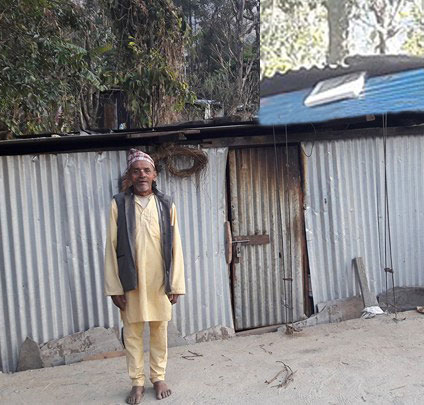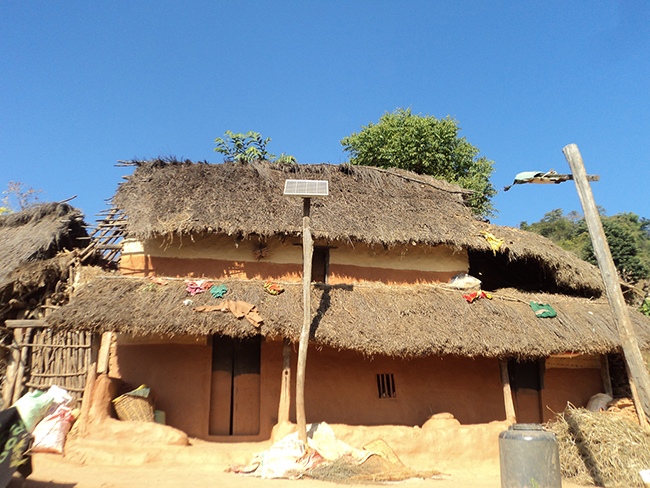“It’s a wonder,” he said, pointing at a small solar device laid on top of a tin roof of a makeshift shed he has been living in for more than two years. Megha Nath, 70, has lived through the darkest and the brightest of times in this village of Bahrabise of Sindhupalchok district, around 90 kilometers away from Kathmandu. “There was a time when there was no source of light. When children had to do homework, they did it during the day,” he said speaking of the ‘dark’ days.

Megha Nath, 70, standing in front of his makeshift shed. Small solar device at inset.
Photo: Mahabir Paudyal/Republica
Megha Nath, an earthquake survivor, first saw electricity in his village in the mid-1990s when it was connected to a national grid. When electricity went out, which happened frequently during the dry seasons, the village would plunge back into darkness.
And for the past month, after the transformer broke down, the village is in a similar state. But Megha Nath and the other villagers have nothing to worry now. Their homes remain illuminated—thanks to small solar panels provided to them in relief aid.
“This is why I say it’s a wonder,” he said. “This panel illuminates two bulbs. And I don’t have to pay for it,” he explained.
The villagers are going to continue with the solar system as the National Reconstruction Authority (NRA), the government body that oversees reconstruction process, has made it mandatory for each beneficiary to either install solar light or bio-gas plant in their homes to be eligible for third installment of housing grants.
Like Megha Nath, a total of 767,705 private householders will have either solar power or bio-gas plant installed when the reconstruction process completes. This will mark a big shift for the country that has relied on petroleum products as the main source of energy and where existing hydro plants have failed to meet the growing energy demands.
Renewable Energy and Future of Sustainable Development

Despite having a hydropower potential above 80,000 MW, solar power potential of around 2,100 MW and wind power potential of 3,000 MW, around 25 percent of Nepal’s population still lives without electricity.
In 2016, biomass accounted for 78.4 percent of energy used in the country. Imports of petroleum products increased by almost threefold between 2000 and 2016, contributing to increasing carbon emissions, air pollution, and negative health impacts. Electricity and renewable sources such as solar and micro-hydro accounted for only 3.7 percent and 2.5 percent respectively, of total energy use in 2016.
Shifting paradigm
Nepal is proactively working for clean energy alternative after 2015 when earthquakes damaged some big hydro power plants and the Indian blockade caused serious energy scarcity including that of cooking gas, diesel, and petrol. This forced the government to introduce more sustainable energy friendly programs and complete existing projects.
Government has increased efforts for innovative renewable energy solutions. In June 2016, a Spanish team studied prospects of producing 3,000 MW of electricity from wind power in Jomsom district. In January this year, it directed Nepal Electricity Authority (NEA), the state owned power utility, to promote solar and wind energy sources so that they make up 10 percent of the total installed capacity. In February, Ministry of Energy issued guidelines for Development of Alternative Energy Connected to Grid 2018, which allows individuals, organizations, and commercial producers to feed electricity generated from solar, wind and biogas plants into the national grid.
With enactment of policies such as Renewable Energy Subsidy Policy (2016) and Biomass Energy Strategy (2017), many positive results have been achieved.

Solar panel installed at a small hut in a village of Tanahu district. Rural householders are increasingly using solar panels to meet energy needs. Photo: Sane Bahadur Nepali/RSS
A 35 KW solar-wind energy project was completed in December 2017, which provided powers to 83 households in Sindhuli district. Kathmandu Metropolitan City (KMC) started producing 14 KW of electricity from waste from June 2017. Solar panels have been installed on the roofs of government offices inside Singha Durbar, the chief secretariat of Nepal government.
Likewise, Alternative Energy Promotion Center (AEPC), the government body that works for development and promotion of renewable and alternative energy technologies, is working in collaboration with Asian Development Bank (ADB) on a project to generate 70 KW of electricity in Panchthar and 50 KW in Bhojpur from solar-wind hybrid project.
According to AEPC’s data, as of January 2018, 388,611 household biogas plants, 117 large biogas plants, 30,397 micro-mini hydropower plants, 808,225 household solar PVs, 1,388, 015 improved cooking stoves, 10,857 improved water mills, 1,719 institutional solar and solar pumping devices, and 65 solar mini-grids have been established in the country. “Some of them have been damaged by 2015 earthquakes and they are being repaired. Otherwise most of them are in operation,” said Nawa Raj Dhakal, director at AEPC. “AEPC’s Energy Crisis Mitigation Plan has envisaged taking 15 percent of energy from the renewables, especially solar and wind.”
Dhakal also stressed on the need to change traditional mindset about energy. “We have been schooled to think that energy is electricity and electricity can be generated only from hydro plants. We did not consider other forms of energy as energy,” he said. “Then when we started to work on it, we called it alternative energy and thought of it only as an alternative. We must develop it as a sustainable renewable mainstream energy.”
In the recent times, however, people’s perception has changed, said Dhakal. People are using solar panels and heaters, and solar streetlights are being installed in cities like Kathmandu and Pokhara.
Potentials for LDCs
Sustainable energy has been identified as a key to lifting least developed countries (LDCs) like Nepal out of poverty. The Istanbul Program of Action for the Least Developed Countries for 2011-2020 (IPoA), for example, has recognized access to affordable, reliable and renewable energy as critical to accelerated growth, improved livelihoods and advanced sustainable development of LDCs. In 2016, LDCs announced Renewable Energy and Energy Efficiency Initiative (REEEI) for Sustainable Development program to scale up renewable energy and promote energy efficiency.
Yet, the fact remains that 70 percent of 900 million people living in LDCs have limited access to energy, with seven out of 10 LDC citizens having no electricity.
“In the lack of energy, women and children in LDCs have to spend time collecting fuel for cooking and building fire. As a result they face a lot of social and environmental problems,” said Gauri Pradhan, international coordinator of LDC Watch. “Improved cooking stoves have helped them to some extent. Government of Nepal has also been working on this. Now it needs to be put on top priority,” he said.
Pradhan says clean energy will help in LDCs’ graduation process. “LDCs have a lot of potentials in wind, solar, and hydro. If they can tap into them all, they will be able to graduate in the next ten years,” he said.
Nepal is the example of a LDC benefitting from carbon trading. In February, Nepal Biogas Promotion Association (NBPA) reported that Nepal is earning one billion rupees annually in carbon trading contributed by biogas sector.
With many potentials and hopes as well as increasing faiths of rural poor like Megha Nath on clean energy, not only LDCs but all countries must tap into this inexhaustible source of energy.
mahabirpaudyal@gmail.com






































